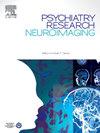自发神经活动介导不良童年经历对情绪障碍患者负性认知风格的影响:一种多变量方法
IF 2.1
4区 医学
Q3 CLINICAL NEUROLOGY
引用次数: 0
摘要
消极的认知方式和自发的神经活动可以揭示抑郁症的认知和神经生物学基础,与不良的临床结果有关,并因不良童年经历(ace)而恶化。本研究探讨了重度抑郁症(MDD)和双相情感障碍(BD)患者的ace、低频波动分数幅值(fALFF)和负性认知风格之间的关系。在94例患者样本中(48例重度抑郁症;46例BD患者和35例匹配的HC患者,采用典型相关分析(Canonical Correlation Analysis)评估fALFF和ace之间的多变量相关性,并使用儿童创伤问卷(Childhood Trauma Questionnaire)进行评分。一个中介模型检验了fALFF在ace对消极认知风格的影响中的中介作用,并通过认知问卷进行评估。在抑郁症患者中,消极认知风格因ace而恶化。认知偏差还与ace相关的自发神经活动模式有关,涉及双侧楔前叶和扣带回后,左背外侧岛和右颞上回。此外,确定的fALFF模式介导了ace对负面事件感知不可控性的影响。HC未见明显结果。这些发现强调了fALFF是一种有希望的内表型,将ace和消极认知风格联系起来,为情绪障碍症状学的神经生物学机制提供了有价值的见解。本文章由计算机程序翻译,如有差异,请以英文原文为准。

Spontaneous neural activity mediates the effect of adverse childhood experiences on negative cognitive styles in mood disorders: a multivariate approach
Negative cognitive styles and spontaneous neural activity can reveal cognitive and neurobiological underpinnings of depression, related to poor clinical outcomes and worsened by Adverse Childhood Experiences (ACEs). This study examined the associations between ACEs, fractional Amplitude of Low Frequency Fluctuations (fALFF), and negative cognitive styles in Major Depressive Disorder (MDD) and Bipolar Disorder (BD). In a sample of 94 patients (48 MDD; 46 BD) and 35 matched HC, Canonical Correlation Analysis was used to assess the multivariate association between fALFF and ACEs, rated with the Childhood Trauma Questionnaire. A mediation model tested the role of fALFF in mediating the effect of ACEs on negative cognitive styles, assessed with the Cognitions Questionnaire. In depressed patients, negative cognitive styles were worsened by with ACEs. Cognitive biases were also associated with an ACEs-related spontaneous neural activity pattern, involving the bilateral precuneus and posterior cingulate gyrus, left dorsolateral insula, and right superior temporal gyrus. Moreover, the identified fALFF pattern mediated the effect of ACEs on the perceived uncontrollability of negative events. No significant results were found in HC. These findings highlight fALFF as a promising endophenotype linking ACEs and negative cognitive styles, offering valuable insight into the neurobiological mechanisms underlying mood disorders symptomatology.
求助全文
通过发布文献求助,成功后即可免费获取论文全文。
去求助
来源期刊
CiteScore
3.80
自引率
0.00%
发文量
86
审稿时长
22.5 weeks
期刊介绍:
The Neuroimaging section of Psychiatry Research publishes manuscripts on positron emission tomography, magnetic resonance imaging, computerized electroencephalographic topography, regional cerebral blood flow, computed tomography, magnetoencephalography, autoradiography, post-mortem regional analyses, and other imaging techniques. Reports concerning results in psychiatric disorders, dementias, and the effects of behaviorial tasks and pharmacological treatments are featured. We also invite manuscripts on the methods of obtaining images and computer processing of the images themselves. Selected case reports are also published.

 求助内容:
求助内容: 应助结果提醒方式:
应助结果提醒方式:


